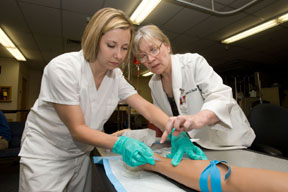ISU College of Technology’s three nursing programs are innovative, effective
June 24, 2009
It may come as a surprise to some that three of Idaho State University’s five current nursing programs are taught by and administered through the ISU College of Technology.
The College of Technology offers the Certified Nursing Assistant (CNA),
Practical Nursing (PN) and Associate Degree Registered Nurse (ADRN) programs for aspiring nurses. The other two, bachelor and master’s nursing programs, are offered through the Kasiska College of Health Professions.
 The College of Technology nursing programs work well individually and collectively. They are designed with students in mind; they are integrated and well-equipped, and have produced excellent results.
The College of Technology nursing programs work well individually and collectively. They are designed with students in mind; they are integrated and well-equipped, and have produced excellent results.
“Frankly, there is some really progressive work going on with our nursing programs in the College of Technology that the University and Idahoans can be very proud of,” said Paul Peterson, Chair of the College of Technology’s Health Occupations Department, which provides a total of 12 health-related programs, from the nursing programs to paramedic science education. “What we offer really helps to meet the needs of both the students and their families, and the Idaho population at large.”
The three programs are correlated. CNA certification is required as a prerequisite to acceptance to the PN program that prepares students to become Licensed Practical Nurses. With LPN licensure, students are eligible for the ADRN program, where graduates can earn licensure as Registered Professional Nurses.

“There are common threads that we have integrated across the continuum of the programs to accomplish the work required in a quality fashion without wasting time and money,” Peterson said.
“It is also very easy for our graduates to link to the Kasiska College of Health Professions and get a bachelor and master of science in nursing,” said Linda S. Smith, director of the ADRN program.
Peterson and Smith’s observations were backed up by Jennie Brumfield, PN instructor, who completed the PN program in 1998, ADRN in 2005 and BSN in 2007. Brumfield is now working on her master’s of nursing degree in the Kasiska College of Health Professions and is scheduled to earn it in 2011.
“The College of Technology nursing programs worked well for me,” Brumfield said. “I probably would never have been an RN (Registered Nurse) if I hadn’t entered the ADRN program, but it was very convenient for me, and I have two kids and was working full time.”
The College of Technology’s nursing programs are geared towards its students. For example, the ADRN program is distance-based; students are required to attend “intensive” on-site sessions several times a month but may complete much of their clinical requirements where they live. This allows students, such as Jesse Kunz, an ADRN student from Bern who works at Bear Lake Memorial Hospital in Montpelier, to conveniently upgrade their nursing knowledge and skills.
“This is a great program for me,” Kunz said. “I am from Bear Lake, a rural area, and this program, with its distance learning, has allowed me to attend school without moving. I’ve had great support from my hospital and a lot of the RN staff there are a product of this (ADRN) program.”
The online learning is augmented by faculty supervised clinical experiences and intensive on-site visits where students learn and practice everything they can’t do online, Smith said. Intensive sessions also include opportunities for students to work together face to face with real and simulated nursing care problems. “During these sessions, students learn to critically think as a team of nursing professionals with faculty oversight and mentorship,” Smith explained.
“The online nature of our didactic (lecture-based) learning by no means limits the hours and clinical experience they have to achieve in a hospital setting,” Peterson said.
While the ADRN is taught largely by distance, the PN program’s lecture component is largely taught in a face-to-face format with students onsite. However, the PN program also features online teaching that can save students time and travel.
All of the students in the College of Technology’s three nursing programs have access to excellent learning resources at the nursing labs in the ISU Continuing Education Building.
“Our human simulation equipment available to the nursing programs far exceeds what one would expect in the standard PN and ADRN nursing programs,” Peterson said. “We have well over a half-million dollars in human simulation equipment.”
By practicing on the sophisticated simulation equipment, with direct faculty oversight, students gain skill and confidence before going into a clinical setting and performing nursing care and procedures with real patients.
The innovative design of the three programs has produced some impressive results.
“We feel great about our students’ comments and the feedback is so positive,” Peterson said. “Our scores on PN and RN national board exams are significantly above the national average, and we regularly receive unsolicited comments from employers of our former students on the quality of our graduates.”
Visit http://www.isu.edu/ctech/healthdepartment.shtml for more information on these programs.
Categories:
